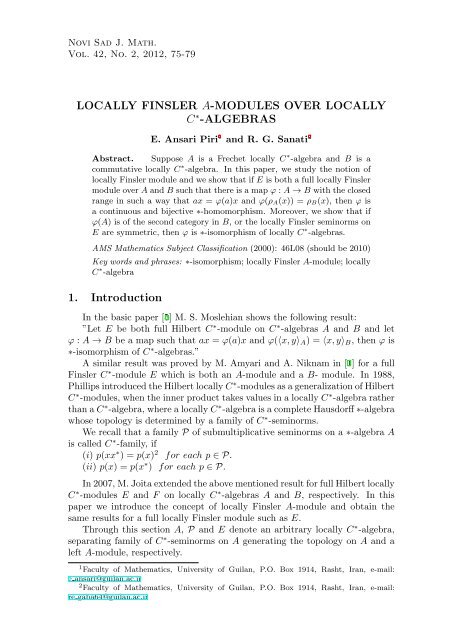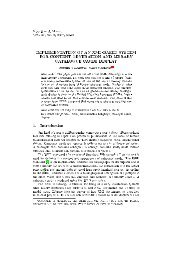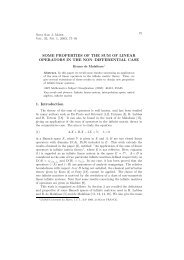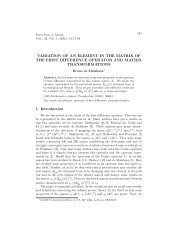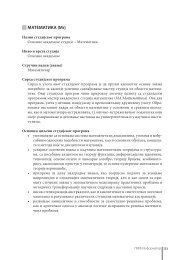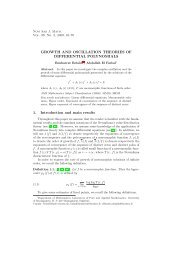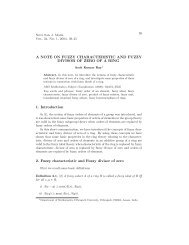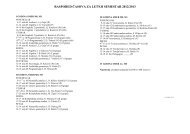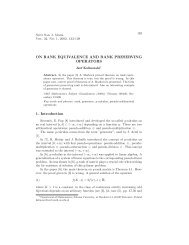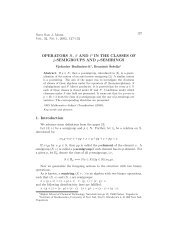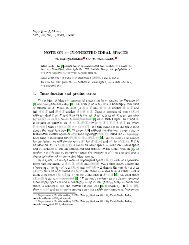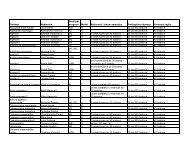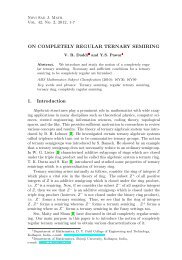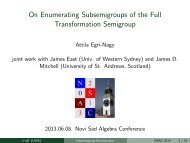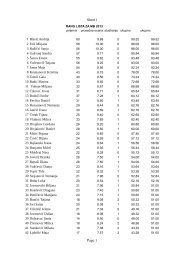LOCALLY FINSLER A-MODULES OVER LOCALLY C -ALGEBRAS ...
LOCALLY FINSLER A-MODULES OVER LOCALLY C -ALGEBRAS ...
LOCALLY FINSLER A-MODULES OVER LOCALLY C -ALGEBRAS ...
Create successful ePaper yourself
Turn your PDF publications into a flip-book with our unique Google optimized e-Paper software.
Novi Sad J. Math.<br />
Vol. 42, No. 2, 2012, 75-79<br />
<strong>LOCALLY</strong> <strong>FINSLER</strong> A-<strong>MODULES</strong> <strong>OVER</strong> <strong>LOCALLY</strong><br />
C ∗ -<strong>ALGEBRAS</strong><br />
E. Ansari Piri 1 and R. G. Sanati 2<br />
Abstract. Suppose A is a Frechet locally C ∗ -algebra and B is a<br />
commutative locally C ∗ -algebra. In this paper, we study the notion of<br />
locally Finsler module and we show that if E is both a full locally Finsler<br />
module over A and B such that there is a map φ : A → B with the closed<br />
range in such a way that ax = φ(a)x and φ(ρ A (x)) = ρ B (x), then φ is<br />
a continuous and bijective ∗-homomorphism. Moreover, we show that if<br />
φ(A) is of the second category in B, or the locally Finsler seminorms on<br />
E are symmetric, then φ is ∗-isomorphism of locally C ∗ -algebras.<br />
AMS Mathematics Subject Classification (2000): 46L08 (should be 2010)<br />
Key words and phrases: ∗-isomorphism; locally Finsler A-module; locally<br />
C ∗ -algebra<br />
1. Introduction<br />
In the basic paper [5] M. S. Moslehian shows the following result:<br />
”Let E be both full Hilbert C ∗ -module on C ∗ -algebras A and B and let<br />
φ : A → B be a map such that ax = φ(a)x and φ(⟨x, y⟩ A ) = ⟨x, y⟩ B , then φ is<br />
∗-isomorphism of C ∗ -algebras.”<br />
A similar result was proved by M. Amyari and A. Niknam in [1] for a full<br />
Finsler C ∗ -module E which is both an A-module and a B- module. In 1988,<br />
Phillips introduced the Hilbert locally C ∗ -modules as a generalization of Hilbert<br />
C ∗ -modules, when the inner product takes values in a locally C ∗ -algebra rather<br />
than a C ∗ -algebra, where a locally C ∗ -algebra is a complete Hausdorff ∗-algebra<br />
whose topology is determined by a family of C ∗ -seminorms.<br />
We recall that a family P of submultiplicative seminorms on a ∗-algebra A<br />
is called C ∗ -family, if<br />
(i) p(xx ∗ ) = p(x) 2 for each p ∈ P.<br />
(ii) p(x) = p(x ∗ ) for each p ∈ P.<br />
In 2007, M. Joita extended the above mentioned result for full Hilbert locally<br />
C ∗ -modules E and F on locally C ∗ -algebras A and B, respectively. In this<br />
paper we introduce the concept of locally Finsler A-module and obtain the<br />
same results for a full locally Finsler module such as E.<br />
Through this section A, P and E denote an arbitrary locally C ∗ -algebra,<br />
separating family of C ∗ -seminorms on A generating the topology on A and a<br />
left A-module, respectively.<br />
1 Faculty of Mathematics, University of Guilan, P.O. Box 1914, Rasht, Iran, e-mail:<br />
e ansari@guilan.ac.ir<br />
2 Faculty of Mathematics, University of Guilan, P.O. Box 1914, Rasht, Iran, e-mail:<br />
re gaba64@guilan.ac.ir
76 E. Ansari Piri, R. G. Sanati<br />
Definition 1.1. The A-valued map ρ A : E → A + is called locally Finsler<br />
seminorm if<br />
(i) For each p ∈ P, ¯p : E → R + with ¯p(x) = p(ρ A (x)) 1/2 is a seminorm on E.<br />
(ii) ρ A (ax) = aρ A (x)a ∗ for each a ∈ A and x ∈ E.<br />
Definition 1.2. If E possesses a locally Finsler seminorm, then E is called a<br />
pre-Finsler A-module. Moreover, if E is complete with respect to the topology<br />
of the family of Finsler seminorms P E = {¯p} p∈P , then E is called a locally<br />
Finsler A-module.<br />
Definition 1.3. A locally Finsler seminorm ρ A on E is called symmetric if for<br />
each a ∈ A and x ∈ E, ρ A (ax) = ρ A (a ∗ x) .<br />
It is clear that if A is commutative, then every locally Finsler seminorm is<br />
symmetric.<br />
Lemma 1.4. Let E be a Finsler A-module and ¯p(x) = p(< x, x >) 1/2 , for each<br />
x ∈ E and p ∈ P. Then ¯p(ax) ≤ p(a)¯p(x).<br />
Proof. Let p ∈ P. Then we have<br />
¯p(ax) 2 = p(ρ A (ax)) = p(aρ A (x)a ∗ ) ≤ p(a)p(ρ A (x))p(a ∗ ) = p(a) 2 ¯p(x) 2 .<br />
It follows that ¯p(ax) ≤ p(a)¯p(x).<br />
2. Full locally Finsler A-module<br />
In this section we study the full locally Finsler A-modules. Through this<br />
section we suppose that {p j } j∈J is a family of separating C ∗ - seminorms on A<br />
and U j = {a ∈ A; p j (a) ≤ 1}.<br />
Definition 2.1. A locally Finsler A-module E is called full if the linear span<br />
of the set {ρ A (x); x ∈ E} is dense in A.<br />
Definition 2.2. A locally C ∗ -algebra A is called Frechet locally C ∗ -algebra,<br />
if its topology is generated by a countable separating family of C ∗ -seminorms.<br />
Lemma 2.3. Let E be a full locally Finsler A-module on a locally C ∗ -algebra<br />
A and a ∈ A. If ρ A (ax) = 0 for each x ∈ E, then a = 0.<br />
Proof. Let ρ A (ax) = 0 or equivalently aρ A (x)a ∗ = 0 for all x ∈ E. For b ∈ A,<br />
the fullness of E implies that there exists a net {b α } α in A such that b = lim α b α<br />
and each b α is of the following form<br />
Now we have<br />
k α<br />
∑<br />
i=1<br />
aba ∗ = lim<br />
α<br />
ab α a ∗ = lim<br />
α<br />
(a<br />
λ i,α ρ A (x i,α )<br />
k α<br />
∑<br />
i=1<br />
(x i,α ∈ E and λ i,α ∈ C).<br />
λ i,α ρ A (x i,α )a ∗ ) = lim<br />
k α<br />
∑<br />
i=1<br />
λ i,α aρ A (x i,α )a ∗ = 0.<br />
Hence for b = a ∗ a we have p j (a) 4 = p j (aa ∗ ) 2 = p j (aa ∗ (aa ∗ ) ∗ ) = 0, which<br />
implies a = 0.
Locally Finsler A-modules over locally C ∗ -algebras 77<br />
As an immediate consequence of this lemma, we have the next corollary:<br />
Corollary 2.4. Let E be a full locally Finsler A-module on a locally C ∗ -algebra<br />
A and a ∈ A. Then a = 0 iff ax = 0 for all x ∈ E.<br />
The following result is due to Phillips [6, Proposition 5.2].<br />
Lemma 2.5. Let φ : A → B be a ∗-homomorphism from a Frechet locally<br />
C ∗ -algebra A into a locally C ∗ -algebra B. Then φ is continuous.<br />
Now we are ready to prove the main result of this paper.<br />
Theorem 2.6. Let E be both a full Finsler module on a Frechet locally C ∗ -<br />
algebra A and on a commutative locally C ∗ -algebra B . Let φ : A → B be<br />
a map with closed range such that ax = φ(a)x and φ(ρ A (x)) = ρ B (x), where<br />
a ∈ A, x ∈ E. Then φ is a bijective continuous ∗-homomorphism.<br />
Proof. Since (φ(ab) − φ(a)φ(b))x = ((ab)x − a(bx)) = 0, by Corollary 2.4<br />
φ(ab) = φ(a)φ(b). Similarly, φ(λa + b) = λφ(a) + φ(b). Therefore φ is a<br />
homomorphism. To show that φ preserves involution, suppose a ∈ A. For<br />
x ∈ E we have, ρ A (ax) = aρ A (x)a ∗ . So<br />
ρ B (ax) = φ(ρ A (ax)) = φ(aρ A (x)a ∗ ) = φ(a)ρ B (x)φ(a ∗ ).<br />
But ρ B (ax) = ρ B (φ(a)x) = φ(a)ρ B (x)φ(a) ∗ . Therefore, we have<br />
φ(a)ρ B (x)(φ(a) ∗ − φ(a ∗ )) = 0.<br />
A similar argument for ρ A (a ∗ x) implies that<br />
φ(a ∗ )ρ B (x)(φ(a) − φ(a ∗ ) ∗ ) = 0.<br />
Since the family of C ∗ -seminorms on B is separating, we have<br />
(φ(a) ∗ − φ(a ∗ ))ρ B (x)φ(a ∗ ) ∗ = (φ(a ∗ )ρ B (x)(φ(a) − φ(a ∗ ) ∗ )) ∗ = 0.<br />
Now commutativity of B implies that<br />
Therefore<br />
φ(a ∗ ) ∗ ρ B (x)(φ(a) ∗ − φ(a ∗ )) = 0.<br />
ρ B ((φ(a) − φ(a ∗ ) ∗ )x) = (φ(a) − φ(a ∗ ) ∗ )ρ B (x)(φ(a) ∗ − φ(a ∗ ))<br />
= φ(a)ρ B (x)(φ(a) ∗ − φ(a ∗ )) −<br />
φ(a ∗ ) ∗ ρ B (x)(φ(a) ∗ − φ(a ∗ )) = 0.<br />
Using Lemma 2.3, φ(a ∗ ) = φ(a) ∗ . Hence φ preserves ∗ and so it is continuous<br />
by Lemma 2.5. Now let φ(a) = 0, then φ(a)x = 0 for every x ∈ E which<br />
implies that ax = 0 for each x ∈ E. Corollary 2.4 shows that a = 0 and so<br />
φ is one to one. Suppose that b ∈ B. There is a net {b α } α in B such that<br />
b α −→ b and each b α is of the form ∑ k α<br />
i=1 λ i,αρ B (x i,α ), in which λ i,α ∈ C<br />
and x i,α ∈ E. Consider a α = ∑ k α<br />
i=1 λ i,αρ A (x i,α ). Clearly, φ(a α ) = b α , so<br />
φ(a α ) −→ b. But the range of φ is closed, hence φ is surjective. Therefore φ is<br />
a bijective continuous ∗-homomorphism.
78 E. Ansari Piri, R. G. Sanati<br />
Corollary 2.7. Let E, A, B and φ be as in Theorem 2.6 such that φ(A) is of<br />
the second category in B. Then φ is a ∗-isomorphism of locally C ∗ -algebras.<br />
In particular, if B is a Frechet locally C ∗ -algebra, then φ is a ∗-isomorphism.<br />
Proposition 2.8. Let E be both full locally Finsler module on Frechet locally<br />
C ∗ -algebras A and B such that ρ B , ρ A are symmetric. Then φ is a<br />
∗-isomorphism of locally C ∗ -algebras.<br />
Proof. We only prove the ∗-preserving of φ. Let a ∈ A and x ∈ E. As in<br />
Theorem 2.6, we have<br />
But,<br />
φ(a)ρ B (x)(φ(a) ∗ − φ(a ∗ )) = 0 = φ(a ∗ )ρ B (x)(φ(a) − φ(a ∗ ) ∗ ).<br />
φ(a ∗ )ρ B (x)(φ(a) − φ(a ∗ ) ∗ ) = φ(ρ A (a ∗ x)) − ρ B (φ(a ∗ )x)<br />
= φ(ρ A (ax)) − ρ B (φ(a ∗ ) ∗ x)<br />
= (φ(a) − φ(a ∗ ) ∗ )ρ B (x)φ(a ∗ ).<br />
Hence, (φ(a) − φ(a ∗ ) ∗ )ρ B (x)φ(a ∗ ) = 0. It follows that<br />
φ(a ∗ ) ∗ ρ B (x)(φ(a) ∗ − φ(a ∗ )) = 0.<br />
Thus, ρ B ((φ(a) − φ(a ∗ ) ∗ )x) = 0. Now we have φ(a) ∗ = φ(a ∗ ) by Lemma<br />
2.3.<br />
In [1], an example is given to show that we can not drop the fullness of E<br />
in Theorem 2.6.<br />
Remark 2.9. Theorem 2.6 shows that, we can substitute the condition ∥ρ A (x)∥<br />
= ∥ρ B (x)∥ of the main Theorem in [1] by commutativity of B (or symmetry of<br />
ρ A , ρ B ) and obtain the same result.<br />
Proposition 2.10. Let E, A, B and φ be as in Theorem 2.6. Then the topology<br />
of the family of seminorms Q E on E is weaker than the topology of the family<br />
of seminorms P E on E.<br />
Proof. We show that the identity map from (E, P E ) onto (E, Q E ) is continuous.<br />
Let q ∈ Q E . Since φ : A → B is continuous, there is p q ∈ P E such<br />
that<br />
q(φ(a)) ≤ p q (a) (a ∈ A).<br />
Let x ∈ E. Then we have<br />
¯q(x) 2 = q(ρ B (x)) = q(φ(ρ A (x))) ≤ p q (ρ A (x)) = ¯p q (x).<br />
So, ¯q(x) ≤ ¯p q (x) and this completes the proof.<br />
Corollary 2.11. Let E, A, B and φ be as in Theorem 2.6. Moreover, if B is<br />
Frechet, then P E and Q E induce the same topology on E.<br />
Proof. It is enough to show that the identity map from (E, P E ) onto (E, Q E )<br />
is a homeomorphism. But this is obvious by the previous proposition.
Locally Finsler A-modules over locally C ∗ -algebras 79<br />
Acknowledgement<br />
The authors would like to thank the referee for valuable suggestions and<br />
comments.<br />
References<br />
[1] Amyari, M., Niknam, A., A note on Finsler modules. Bull. Iran Math. Soc. 29<br />
(2003), 77-81.<br />
[2] Bakić, D., Guljaš, B., On a class of module maps of Hilbert C ∗ -modules. Math.<br />
Commun. 7 (2002), 177-192.<br />
[3] Inoue, A., Locally C ∗ -algebra. Mem. Fac. Kyushu. Univ. Ser. A 25 (1971),<br />
197-235.<br />
[4] Joiţa, M., A note about full Hilbert modules over Frechet locally C ∗ -algebras.<br />
Novi Sad J. Math. 37 (2007), 27-32.<br />
[5] Moslehian, M. S., On full Hilbert C ∗ -modules. Bull. Malays. Math. Sci. Soc. 24<br />
(2001), 45-47.<br />
[6] Phillips, N. C., Inverse limits of C ∗ -algebras. J. Operator Theory 19 (1988),<br />
159-195.<br />
[7] Tagavih, A., Modules with seminorms which take values in a C ∗ -algebra. Int.<br />
J. Math. Anal. 3 (2009), 1917-1922.<br />
[8] Wegge-Olsen, N. E., K-theory and C ∗ -algebras. OUP, 1993.<br />
Received by the editors August 8, 2011


